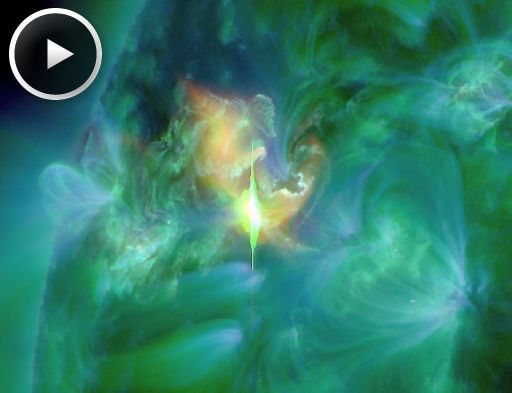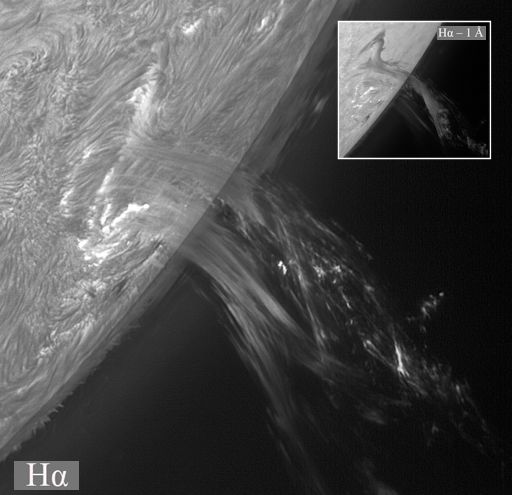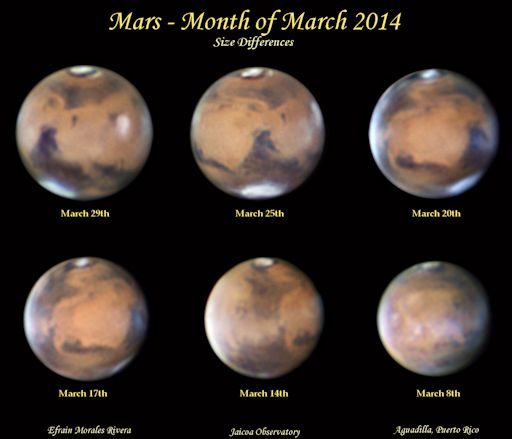Listen to radar echoes from satellites and meteors, live on listener-supported Space Weather Radio. | | |
WAITING FOR CMES: Arriving a little later than expected, at least three CMEs are still en route to Earth. NOAA forecasters expect glancing blows to commence on April 2nd with a 60% chance of polar geomagnetic storms when the impacts begin. High-latitude sky watchers should be alert for auroras.. Aurora alerts: text, voice
M6-CLASS SOLAR FLARE: Northern sunspot AR2027 erupted on April 2nd at 14:05 UT, producing a significant M6-class solar flare. NASA's Solar Dynamics Observatory recorded the extreme ultraviolet blast:

In the movie, you can see material being hurled into space. That is the genesis of a spectacular CME now racing away from the sun's eastern limb. Our planet was not in the line of fire, but the expanding cloud might nevertheless have an Earth-directed component. Stay tuned for updates. Aurora alerts: text, voice
Realtime Space Weather Photo Gallery
DAYLIGHT REQUIRED: In the night sky, there are thousands of stars visible to the unaided eye, and thousands of times more stars in range of backyard optics. Not a single one of those faraway balls of fire, however, looks any bigger than a pinprick. For a better view of a star, you need some daylight:

This star is the sun. Francois Rouviere of Mougins, France, took the picture on March 31st using no more than a 7-inch refracting telescope and an "H-alpha" filter tuned to the red glow of solar hydrogen.
"I caught this impressive explosion at the sun's western limb near sunspot AR2014," says Rouviere. "The inset, which is at a wavelength 1 Å shorter than H-alpha, shows fast moving material blue-shifted by the Doppler effect."
Got a solar telescope? NOAA forecasters estimate a 40% chance of M-class flares and a 5% chance of X-flares on April 2nd. Train those optics on the daylight sky. Solar flare alerts: text, voice
Note: Always use safe solar filters when observing the sun. Unfiltered sunlight, focused by optics, can cause serious eye damage.
Realtime Space Weather Photo Gallery
APPROACHING MARS: In the next 60 seconds you will be 300 km closer to the planet Mars. As April begins, Earth and Mars are converging at 5 km/s or 300 km/min for a close approach two weeks from now. This matrix of images, taken by Puerto Rican photographer Efrain Morales Rivera, shows how the Red Planet has grown in the eyepiece of his 12-inch telescope over the past month:

Even the smallest of Rivera's images shows the martian North Polar Cap, orographic clouds over volcanoes near the equator, and a bright blue cloud filling Hellas Basin in the south. Only an experienced astrophotographer can produce this kind of Hubblesque detail using backyard optics. Novice observers looking through the eyepiece of a small telescope can still see a lot, however, including the rusty-red disk of Mars and bright smudges corresponding to the polar cap and Hellas Basin.
Closest approach, Earth to Mars, occurs on April 14th at a distance of 92 million kilometers. Mark your calendar and get ready to see Mars at its best.
Realtime Mars Photo Gallery
Realtime Comet Photo Gallery
Realtime Aurora Photo Gallery
Every night, a network of NASA all-sky cameras scans the skies above the United States for meteoritic fireballs. Automated software maintained by NASA's Meteoroid Environment Office calculates their orbits, velocity, penetration depth in Earth's atmosphere and many other characteristics. Daily results are presented here on Spaceweather.com.
On Mar. 31, 2014, the network reported 9 fireballs.
(9 sporadics)

In this diagram of the inner solar system, all of the fireball orbits intersect at a single point--Earth. The orbits are color-coded by velocity, from slow (red) to fast (blue). [Larger image] [movies]
Potentially Hazardous Asteroids (
PHAs) are space rocks larger than approximately 100m that can come closer to Earth than 0.05 AU. None of the known PHAs is on a collision course with our planet, although astronomers are finding
new ones all the time.
On April 2, 2014 there were 1463 potentially hazardous asteroids.
Notes: LD means "Lunar Distance." 1 LD = 384,401 km, the distance between Earth and the Moon. 1 LD also equals 0.00256 AU. MAG is the visual magnitude of the asteroid on the date of closest approach. | | The official U.S. government space weather bureau |
| | The first place to look for information about sundogs, pillars, rainbows and related phenomena. |
| | Researchers call it a "Hubble for the sun." SDO is the most advanced solar observatory ever. |
| | 3D views of the sun from NASA's Solar and Terrestrial Relations Observatory |
| | Realtime and archival images of the Sun from SOHO. |
| | from the NOAA Space Environment Center |
| | the underlying science of space weather |

